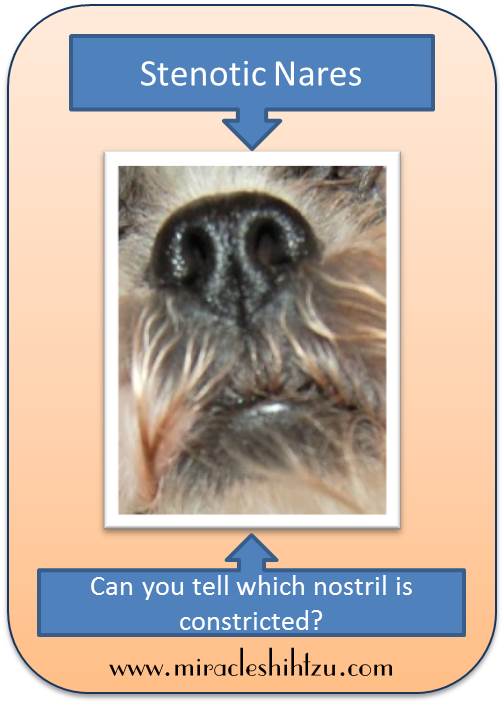Stenotic Nares: Is Your Dog at Risk?
by Janice Jones |Last updated 05-06-2021
Stenotic nares is a condition where there is a narrowly restricted nostril which puts a strain on breathing and can lead to an enlargement of the heart.
Narrowed nostrils or pinched nostrils are two other terms used to describe the problem. This narrowing causes a limit on the amount of air that can flow into the nostrils and eventually the lungs.
Stenotic Nares and Brachycephalic Syndrome
Stenotic Nares is a relatively common condition in Shih Tzu dogs and is the result of a group of problems that plague Brachycephalic breeds.
The brachycephalic syndrome also includes palate and trachea abnormalities leading to a progressive decline in respiratory function.
Any dog that has a flat face with shorter nose such as the Pekingese, Pug, Bulldog, Cavalier King Charles Spaniel, Boston Terriers, or Boxer among others is a potential candidate for the stenotic nares. These narrow nostrils are not restricted to dogs but occur in some cat breeds with flat faces such as Persians and Himalayan cats.
Symptoms of Stenotic Nares
 This dog slight problem, but it does cause her to have loud breathing at times.
This dog slight problem, but it does cause her to have loud breathing at times.This condition is congenital or present at birth and inherited. It will cause sniffling, sneezing, snoring, snorting, grunting and clear nasal discharge. The more the nares are pinched, the greater the likelihood of symptoms and breathing difficulties. In some dogs, the problem is so severe that the dog is forced to breathe through his mouth.
Besides the loud breathing sounds, you might also notice that the dog cannot play for very long before having to take a break and rest. His gums may be pale or even blue if they are not getting enough oxygen into their lungs. In severe cases, the newborn puppy does not make it past the weaning phase.
In older dogs, the snorting noise you hear may be cute, but may be one indication that the dog is having trouble moving air in and out. But you don’t have to wait to hear that snort. Stenotic Nares is easy to diagnosis simply by looking at a dog’s nose. Healthy noses will have well-formed openings.
- Noisy breathing
- Unable to exercise for very long
- Blue or Pale colored gums
- Fainting
- Lethargy
Diagnosis
The determination is made by visually inspecting the openings and is likely to be something that your vet will recognize on the puppy’s first visit. If other problems associated with the brachycephalic syndrome are present, they are not as easily visualized.
Treatment
If the opening in the nostrils is tiny, the vet may suggest surgery to improve the airflow through the nostrils.
The procedure involves removing a small wedge-shaped piece of the nose tissue. Many vets will recommend that this surgery is postponed until the dog is neutered or spayed at about the age of 6 months.
If the opening is just slightly narrowed, other measures may be helpful.
- Mild exercise with a proper diet to maintain optimal weight
- Avoid high heat or humidity
- Use a harness instead of a collar
- Use a water bottle instead of a bowl
Sometimes anti-inflammatory medications, steroids or oxygen therapy may be required to relieve symptoms.
"Hi, I'm Janice Jones, a former veterinary technician and Shih Tzu expert with over 40 years of experience with the breed. Through Miracle Shih Tzu, I combine my medical background and extensive breed knowledge to provide reliable, practical advice for Shih Tzu owners. My mission is to help you give your Shih Tzu the happiest, healthiest life possible through evidence-based information and real-world solutions. Whether you're new to the breed or a seasoned owner, you'll find trusted guidance here for all aspects of Shih Tzu care.
I hold an undergraduate degree in Psychology with a minor in biology, Early Childhood Education, and Nursing, and a Master's in Mental Health Counseling.



